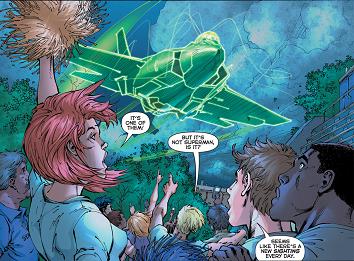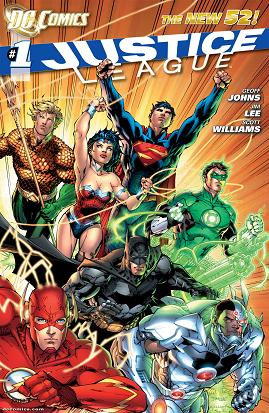Over at The Comics Journal, Ken Parille dissects Justice League #1, concluding:
JL#1 still baffles me. Could it really be as bland as I think it is? Could it be that the creators achieved exactly what they wanted? Am I missing something: are the references to Lexcorp and Darksied key in some way?
For me, superhero comics can’t be good when they’re burdened by a need to be an earth-shattering event, taking us back to DAY ONE and starting all over again. Every aspect of this comic works toward attaining the same register: High Intensity. It has little sense of verbal or visual rhythm—there’s no flow and no mystery.
And it has little plot to speak of, other than heroes fighting aliens and bickering. Much of this “plot” revolves around the big reveal of Superman on the last page, a moment Batman and Green Lantern have been anticipating . . . and fearing. When he appears, it’s a major deal for them. But not for me, and I doubt for most readers.
This is a problem. The story may be compelling for the characters living it out, but as a reader who knows exactly where it’s going—having seen hundreds of comics take this worn path—it’s not an event, but a drag.
It’d be like thinking you’re writing a “mysterious stranger” narrative, but you show him on the book’s cover, name him early on, and talk about him a few times, and make him a character that literally every reader knows: America’s most recognizable icon, the Man of Steel.
Now of course, this being a superhero comic being dissed at the Journal, the fanboys out of the woodwork came. Yet there’s something off about the very first comment, which complains about Ken complaining about Green Lantern creating a big green fighter jet for him and Batman to travel around in. See if you can spot what’s off about this and remember, this is the first issue of the first comics in the post-reboot DC universe. Take it away Francisco Silva:
Hal Jordan, the Green Lantern, is a fighter pilot by profession, it makes perfect sense he would make a fighter plane. Actually seeing as his power is to make green light constructs, he actually knows the mechanics of the F-15, therefore being able to make it work. From the moment you don’t get the character, or his motivations, I am pretty sure you are not going to get anything else.
That’s right, how does Francisco know this? Nowhere in Justice League #1 is Green Lantern’s profession mentioned, nor any of the details of how his powers work that people later in the thread come up with to explain why GL made that frikking fighter plane. The only way we know that this is Hal Jordan, who was a fighter pilot before he became a cosmic cop is that we remember this from the old DC universe, where this was true. But this isn’t meant as a gotcha against Francisco, because as Ken also indicates in his review in those last two paragraphs, this comic, the first in a bold new DC universe depends for all its impact on the associations the readers bring along from the old DC.
Thought experiment time. For Batman, Green Lantern and Superman, substitute one of the very many imitators they’ve all had over the years, some dumb old analogue from one of the nineties superhero universa that nobody remembered or cared for. Having doen so, would this comic make any sense, once you lose all the emotional baggage “Batman”, “Green Lantern” and “Superman” bring with them?
I think not.
It’s the fundamental irony of this reboot: for all it tries to be new, different and accessible for new readers, it still depends on the seventyplus years of baggage these characters drag with them, because otherwise nobody would care. Without that history as a crutch, a reboot like the NuDC is just not possible. And of course it does mean that the reboot will fail and the “new” continuity will get as tangled as the old one was, within the year.
(Apart from all that, Justice League #1 is still a bad comic which doesn’t even tells a complete story or even a chapter in a story, but just goes through the motions as it cycles through a series of bad action movie scenes.)

